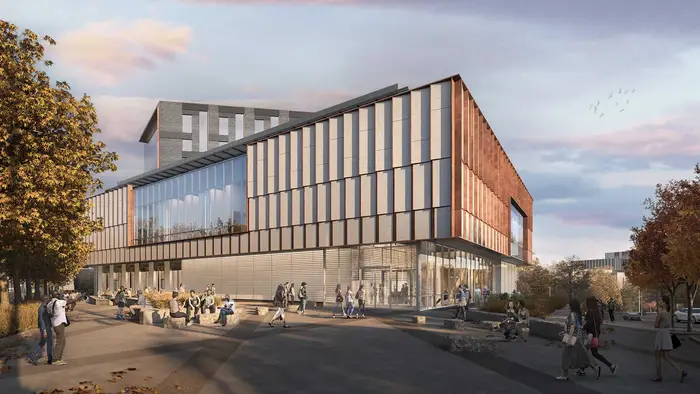

Carnegie Mellon Breaks Ground for Richard King Mellon Hall of Sciences
Innovative facility will bring together foundational science, computer science and art
Media Inquiries
Carnegie Mellon University has broken ground for construction of its Richard King Mellon Hall of Sciences, a 338,900 square-foot building for education, research, art and creativity unlike any other on its campuses.
Anchoring the corner of Forbes Avenue and Craig Street in Pittsburgh’s Oakland neighborhood, the building will enliven a prominent thoroughfare and serve as the new western gateway to the university’s campus. The unique facility will be home to departments from the Mellon College of Science(opens in new window) and School of Computer Science(opens in new window), as well as the Institute for Contemporary Art Pittsburgh, creating an atmosphere that facilitates collaboration across disciplines to advance data-driven research and creative inquiry. Construction is expected to be completed in 2027.
University administrators, faculty, staff and students; elected officials and community partners; and project supporters gathered on Friday, April 12, for the ceremonial groundbreaking event.
"Modern science is at a crossroads, and the future of U.S. innovation is inextricably linked to our nation’s capacity to drive scientific and technological advances," CMU President Farnam Jahanian(opens in new window) said. "The Richard King Mellon Hall of Sciences will position Carnegie Mellon University to excel at this crossroads and usher in new levels of collaboration while creating new paradigms for discovery and accelerating our institutional mission of leveraging knowledge for society's gain. We are deeply committed to advancing this vision and grateful to our supporters for their transformation investments in our future.”
Construction of the Hall of Sciences has been made possible by a $75 million lead grant from the Richard King Mellon Foundation(opens in new window), part of a historic $150 million partnership that was the largest single grant in the foundation’s history.
In addition, the Institute for Contemporary Art Pittsburgh wing is supported by a lead $15 million commitment from the Juliet Lea Hillman Simonds Foundation and the Henry L. Hillman Foundation(opens in new window). The university also has announced major gifts for the project from trustees, alumni and partners including Ray and Stephanie Lane, Cindy and Tod Johnson, Frank Brunckhorst, the late Glen de Vries, and the Jack Buncher Foundation and the Jack G. Buncher Charitable Fund. Fundraising for the project is ongoing.
“Building on CMU’s historic work in the life sciences and the physical sciences, the new Hall of Sciences will be a place where scientists here and around the world collaborate to advance humanity. Here, they will make discoveries and uncover insights and advancements that will improve the human condition,” said Sam Reiman(opens in new window), trustee and director of the Richard King Mellon Foundation. “And — since this is CMU — we know the academic work practiced in this building also will generate new life-science companies. And they, too, will improve and save lives.”
The Hall of Sciences is the cornerstone of the university’s future of science initiative, a decade-long effort to revolutionize and accelerate research and education, leading to innovations and breakthroughs that will benefit humankind. The Mellon College of Science’s Biological Sciences(opens in new window) and Chemistry Departments(opens in new window), along with the interdisciplinary Neuroscience Institute(opens in new window), will have new homes in the building.
“This will be a hub, an intersection, of all the greatness of Carnegie Mellon. The sciences, engineering, computer science and fine arts, intersecting in one place.” — Ray Lane
Joining them will be the fast-expanding, leading-edge Ray and Stephanie Lane Computational Biology Department(opens in new window), the Language Technologies Institute(opens in new window) and the Machine Learning Department(opens in new window) from the School of Computer Science. By co-locating faculty and students from both MCS and SCS, the project will facilitate new research partnerships that will combine artificial intelligence, data analytics and foundational sciences to answer critical questions and solve previously unsolvable challenges.
“The new Richard Mellon King Hall of Sciences will allow us to strengthen existing interactions and help us to develop new opportunities to connect and solve these critical problems now and in the future,” said Veronica Hinman(opens in new window), head of the Department of Biological Sciences. “The new building will be more than just new lab spaces and offices. It will be a hub where committed citizens and scientists from biology, chemistry, computational biology, machine learning and others will meet and share ideas and knowledge in the hallways and study spaces. Those interactions could lead to changing ways of thinking and approaching science that will stand the test of time.”
The Institute for Contemporary Art Pittsburgh will benefit from a greatly expanded home in the Hall of Sciences. The cultural and civic anchor of the building, the ICA Pittsburgh will double its exhibition space, allowing an expansion of its programming and further contributing to the global arts and culture conversation. With a more visible location adjacent to the renowned Carnegie Museum of Art, the ICA Pittsburgh will attract increased visitors and spark new collaborations.
“What this building does, in its very conception, is to make the statement that our similarities across fields are stronger, and that they hold more potential, than our differences,” said Elizabeth Chodos(opens in new window), ICA director and the Johnson Family Public Art Curator(opens in new window). “And despite our tendencies to sometimes decamp into the comforts of our disciplinary silos, when the walls between us are low, and we share space, we begin to see that at the very core, what happens in laboratories and in artists’ studios is not so different. We are all engaged in generating new knowledge out of a commitment to experimentation.”
Designed by ZGF Architects(opens in new window), the striking building will have elements that echo symbols at the core of CMU’s identity: its tartan and the thistle at the center of its official seal. Inside, its occupants will benefit from cutting-edge teaching and research laboratories, classrooms and lecture halls of various sizes, and work and collaboration spaces. A full-service restaurant and multiple interior and exterior spaces for gatherings will further activate the building and draw visitors. The university is developing the project for Gold LEED Certification, a standard for buildings that are highly environmentally efficient.
“This will be a hub, an intersection, of all the greatness of Carnegie Mellon. The sciences, engineering, computer science and fine arts, intersecting in one place,” said CMU Trustee Ray Lane(opens in new window). “... I expect the next 30 years to be about the sciences, computation, engineering and fine arts coming together into this hall to make meaningful changes in the human condition. … It’s going to be a great future.”




